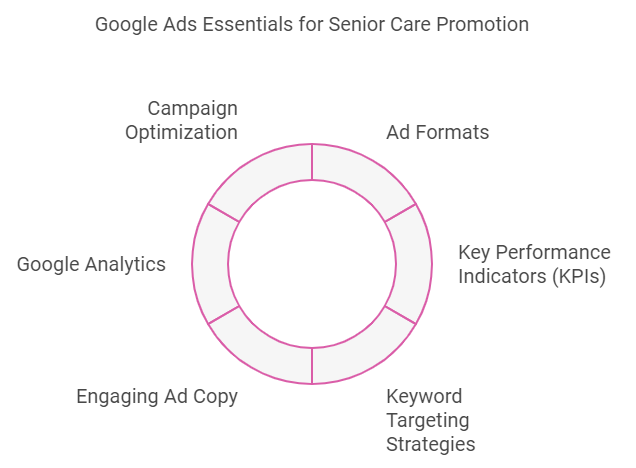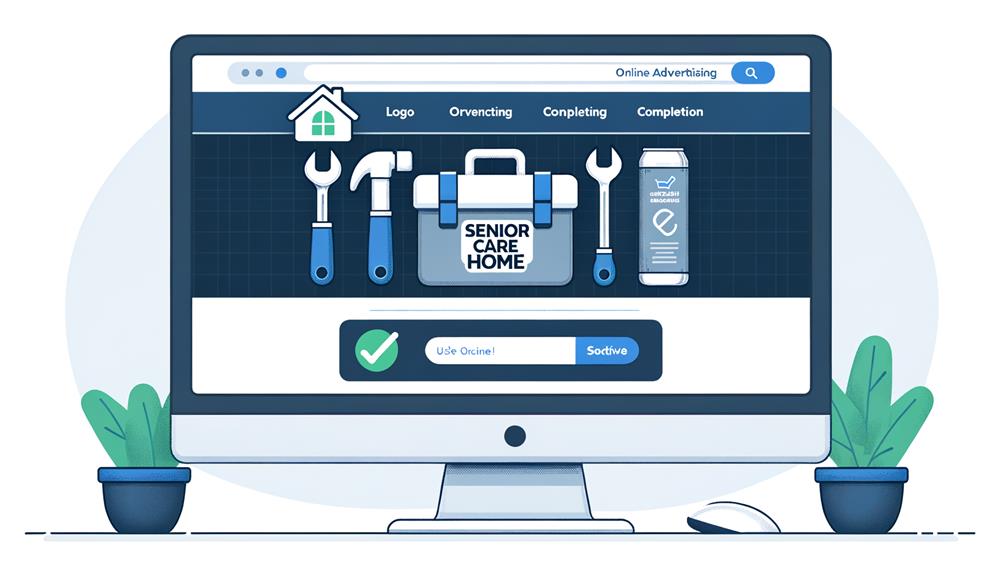Launching a successful Google Ads campaign for your senior care home requires a systematic approach grounded in expertise and strategic planning. We begin by gaining a comprehensive understanding of Google Ads fundamentals. This includes in-depth keyword research focusing on terms like ‘senior care home’ and ‘assisted living’. Next, we craft compelling ad content that resonates with your target audience, utilizing relatable language, regional terminology, and real-life testimonials to build trust. Optimizing landing pages with clear call-to-action buttons and ensuring mobile responsiveness enhances user experience and conversion rates. Continuous monitoring and refinement using tools like Google Analytics are essential for maximizing the campaign’s effectiveness. In this guide, we will detail each of these steps to provide a clear roadmap for your advertising efforts.
Understanding Google Ads Basics
Understanding the fundamentals of Google Ads is essential for effectively promoting a senior care home. This includes familiarizing yourself with various ad formats, key performance indicators (KPIs), keyword targeting strategies, crafting engaging ad copy, leveraging Google Analytics, and implementing ongoing campaign optimization.

Google Ads offers multiple ad types, including Search, Display, and Video ads, among others. This diversity allows advertisers to tailor their approach to reach potential clients of assisted living facilities effectively. For instance, Search ads can capture users actively searching for senior care services, while Display ads can increase brand awareness across relevant websites.
Measuring the effectiveness of your campaign is crucial. Key metrics to monitor include conversion rate, click-through rate (CTR), and return on investment (ROI). These indicators provide insights into how well your ads are performing and where improvements can be made.
Keyword selection and compelling ad copy are vital components of a successful Google Ads campaign. Utilizing tools like the Google Keyword Planner can help identify high-performing keywords relevant to your services. Additionally, integrating Google Analytics allows for in-depth tracking of user behavior and campaign performance, enabling data-driven decisions for continuous optimization.
Initiating Keyword Research and Planning
Initiating comprehensive keyword research is a critical step in setting up a successful Google Ads campaign for a senior care home. By targeting specific terms such as ‘senior care home’, ‘assisted living facility‘, and ‘elderly care services‘, you can effectively reach your intended audience. Utilizing the Google Keyword Planner provides valuable insights into search volumes and keyword competitiveness and can help identify additional relevant keywords.

Employing a strategic mix of broad and long-tail keywords ensures that your ads capture a wide range of search queries while targeting more specific user intents. Prioritizing keywords that accurately reflect your services, amenities, and geographical location enhances the relevance of your ads to potential clients.
It’s important to regularly review and refine your keyword list based on performance data. By analyzing data such as click-through rates and conversion rates, you can optimize your keyword strategy to improve campaign effectiveness. This continuous optimization ensures that your senior care home remains visible to those actively seeking your services.
Crafting Compelling Ad Content
Crafting compelling ad content is essential to highlight the unique qualities of your senior care home while establishing a personal connection with your target audience. Incorporating localized search terms, such as ‘senior care home near me’, can improve visibility among local searchers.

- Emotional Resonance: Utilize a language that empathetically addresses prospective residents and their families’ concerns and emotions. This approach can build a strong emotional connection and demonstrate understanding of their needs.
- Highlighting Specific Services: Focus on the specific needs your facility meets, such as specialized care options, amenities, or community activities. Communicating these benefits can stimulate interest and encourage engagement.
- Including Testimonials: Incorporating testimonials from current residents and their families adds credibility and builds trust. According to BrightLocal’s Local Consumer Review Survey, 87% of consumers read online reviews for local businesses, highlighting the impact of testimonials on potential clients.
By creating ad content that emphasizes your senior care home’s strengths and aligns with your audience’s emotional and practical needs, you can enhance the likelihood of attracting qualified leads.
Building Effective Landing Pages
Designing an effective landing page is crucial for converting visitors into potential residents for your senior care home. A well-crafted landing page should clearly present your services, highlight amenities, and showcase the proficiency of your staff, thereby building trust with prospective clients. Including testimonials and reviews can further enhance credibility and reassure visitors of the quality of care provided.

Prominent and clear call-to-action (CTA) buttons, such as ‘Schedule a Tour’ or ‘Contact Us’, are essential for guiding visitors towards taking the next step. Ensuring that your landing page is mobile-friendly is vital, as a significant number of users search for services on mobile devices. According to Statista, mobile internet usage continues to grow globally, underscoring the importance of mobile optimization.
Implementing A/B testing can optimize landing page performance. By experimenting with different elements such as images, colors, and copy, you can identify the most effective design and messaging. Tools like Google Optimize can facilitate this process, allowing for data-driven enhancements to your landing pages.
Monitoring and Optimizing Campaign Performance
With optimized landing pages established, it is imperative to monitor and optimize your Google Ads campaign’s performance continuously. Assessing whether your ads are meeting their objectives involves tracking key performance metrics using tools like Google Analytics and Google Ads Reports.

Key metrics to monitor include:
- Conversion Rate: The percentage of users who take a desired action after clicking your ad, such as filling out a contact form or scheduling a tour.
- Click-Through Rate (CTR): The ratio of users who click on your ad to the number of total users who view the ad. A higher CTR indicates that your ad is relevant and engaging to your audience.
- Cost Per Click (CPC): The average amount you pay for each click on your ad. Monitoring CPC helps manage your advertising budget effectively.
Analyzing these metrics enables you to identify areas for improvement. For instance, a low conversion rate might indicate a need to adjust your landing page or ad copy. Regular optimization based on data insights ensures your campaign remains effective and provides a good return on investment.
Frequently Asked Questions
How Do I Set Up a Google Ads Campaign?
Setting up a Google Ads campaign involves several key steps:
- Create a Google Ads Account: Sign up for a Google Ads account.
- Define Your Campaign Goals: Determine what you aim to achieve, such as increasing website traffic, generating leads, or boosting brand awareness.
- Select Campaign Type: Choose the appropriate campaign type (e.g., Search, Display, Video) based on your goals.
- Keyword Research: Use the Google Keyword Planner to identify relevant keywords that align with your services.
- Set Targeting Parameters: Specify geographic locations, demographics, and devices to reach your desired audience.
- Create Ad Groups and Ads: Organize keywords into ad groups and craft compelling ad copy for each group.
- Set a Budget and Bidding Strategy: Determine your daily budget and choose a bidding strategy that aligns with your goals, such as maximizing clicks or conversions.
- Implement Ad Extensions: Enhance your ads with ad extensions like sitelinks, call buttons, or location information.
- Launch and Monitor: Review your settings and launch the campaign. Continuously monitor performance and make adjustments as needed.
By carefully selecting keywords, writing engaging ads, and targeting the right audience, you can effectively set up a Google Ads campaign that meets your objectives.
How Much Does a Google Ads Campaign Cost?
The cost of a Google Ads campaign varies widely and depends on several factors:
- Keyword Competitiveness: Highly competitive keywords may have higher cost-per-click (CPC) rates due to demand.
- Geographic Targeting: Advertising in densely populated or high-income areas may increase costs.
- Ad Quality and Relevance: Higher quality scores can lower your CPC. This score is influenced by the relevance of your ad and landing page to the keywords.
- Budget Settings: You control your daily or monthly budget, determining how much you’re willing to spend.
On average, small to medium-sized businesses spend between $1,000 and $10,000 per month on Google Ads. It’s crucial to monitor your campaign’s performance and adjust your budget and bidding strategies accordingly to maximize ROI. Tools like the Google Ads Budget Report can help you manage and forecast your spending.
What Are the Requirements for a Google Ads Campaign?
To launch a successful Google Ads campaign, ensure the following elements are in place:
- Website or Landing Page: A professionally designed, user-friendly website or landing page that provides relevant information and encourages conversions. Ensure it adheres to Google’s Destination Requirements.
- Google Ads Account: Sign up for a Google Ads account to create and manage your campaigns.
- Clear Objectives: Define specific goals, such as increasing leads, sales, or website traffic.
- Keyword Strategy: Develop a list of targeted keywords relevant to your services, using tools like the Google Keyword Planner.
- Compelling Ad Copy: Write engaging and relevant ads that include strong calls to action and comply with Google’s Ad Policies.
- Budget and Bidding Strategy: Establish a realistic budget and choose a bidding strategy that aligns with your objectives.
- Conversion Tracking: Set up conversion tracking to measure the effectiveness of your ads.
- Understanding of Target Audience: Gain insights into your audience’s needs and behaviours to tailor your ads effectively.
- Compliance with Policies: Ensure all aspects of your campaign comply with Google’s Advertising Policies.
Leveraging tools like Google Analytics can help you monitor performance and make data-driven adjustments to optimize your campaign for better ROI.
How Do I Target Google Ads by Age?
To target your Google Ads to specific age groups, follow these steps:
- Navigate to Your Campaign: In your Google Ads account, select the campaign or ad group you wish to adjust.
- Access Demographic Settings: Click on the ‘Demographics’ tab in the left-hand menu.
- Select Age Targeting: Under the ‘Age’ section, adjust your targeting by selecting the age brackets relevant to your campaign. Options typically include:
- 18-24
- 25-34
- 35-44
- 45-54
- 55-64
- 65+
- Exclude Irrelevant Ages: If you wish to exclude certain age groups, adjust the bid modifiers or exclude them entirely.
By targeting the 65+ age group or the age group of decision-makers (e.g., 45-64 who may be adult children seeking care for their parents), you can ensure your ads are displayed to the most relevant audience. For more detailed instructions, refer to Google’s guide on Demographic Targeting.



